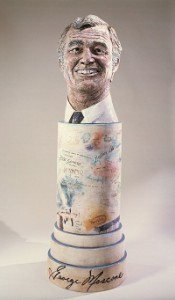
On Friday, a once-controversial bust of assassinated San Francisco mayor George Moscone went on displayat the San Francisco Museum of Modern Art.
From Friday's Chronicle piece on the sculpture:
The pastel-hued pedestal - incised graffiti-like with everything from Moscone's alma mater to the Twinkies associated with killer Dan White's consumption of sugary junk food that supposedly blurred his senses - shocked people. Arneson, who simply said he was a realist sculptor who "doesn't deal with illusion," received death threats.
The Chron's John King described it this way in a 2008 column:
The ceramic sculpture commissioned for $37,000 captured Moscone's ebullient personality - and sat atop a pedestal adorned with crude allusions to the killings, such as blood-like splatters of red glaze and the words "BANG BANG BANG BANG BANG."
Moscone, of course, was killed by ex-San Francisco Supervisor Dan White right after White killed Harvey Milk.
Neal Benezra, Director of the San Francisco Museum of Modern Art, told KQED's Stephanie Martin on Friday that "a lot of people are really curious about it and spending a lot of time looking at the bust in quite a serious way." Here's an edited version of that interview, which touched on both the controversy that erupted in 1981 when the bust was first commissioned, and the sculpture's aesthetic merits...
STEPHANIE MARTIN: Who's Robert Arneson and where does the bust fit into his overall body of work?
NEAL BENEZRA: Robert Arneson is a ceramic sculptor and a leading figure in the Bay area art movement. He taught for many years at UC Davis and had quite a long and very important career.
Arneson was commissioned by the San Francisco Arts Commission to create a portrait bust of the late mayor George Moscone for the Moscone Center as it was approaching completion in 1981.
He always made work that had a kind of serious humor about it. The assassination of Moscone and Harvey Milk was obviously one of the most traumatic moments in the history of this city, but I think he was probably surprised by the depth of feeling that still resided considering these twin assassinations.
STEPHANIE MARTIN: What about the sculpture provoked people so much?
NEAL BENEZRA: What stirred all the controversy was the graffiti-like inscriptions that Arneson attached to the pedestal on which the bust sits. So you can walk around it and read the whole history of Moscone's life – it's kind of a cryptic biography, if you will -- where he went to school, when he got married, his family names, his wife's name.
Then it gets into the facts of his assassination and the trial of Dan White that followed. It's one thing to know facts, but when you see them imprinted on a work of art in a kind of historical way, it takes on another meaning.
And I've come to believe it wasn't so much the pedestal bust and what Arneson inscribed into it that was so troublesome, it was the fact that Dan White seemed to have received such a modest sentence for these terrible crimes. And it kind of scraped open a wound that had only recently begun to heal. It stirred that emotion and that passion that this had not been a trial that had been fair.
So to me it's less the art than the memory of the fact that made the piece so powerful and in fact so controversial.
The piece was presented in the Moscone Center. The purchase had not yet been approved by the San Francisco Arts commission. My understanding is the commission decided, probably after a conversation with the new mayor Dianne Feinstein, that it was simply not appropriate at the time. I know the mayor felt it was time to heal the wounds that this terrible episode had rubbed raw, and it was felt that this did not help in that regard.
So the piece was rejected by the arts commission. It went back to the artist and was then on the private art market for a period of time.
We were able to acquire it after many attempts to acquire it by me and our senior curator of painting and sculpture.
STEPHANIE MARTIN: Why did you want it to be part of your permanent collection so badly?
NEAL BENEZRA: It's very important for a number of reasons. First it's a historical document of this moment in the history of San Francisco. But I don't think that would be enough of a reason for us to acquire it. It's got to be a great work of art as well. And it has the same power, I would argue, 31 years after its making as it did in 1981. It still has an incredible visual presence and great power as a work of art. I think one has to be impressed by the beauty of the bust. It's an incredible likeness of Moscone, with a big smile on his face. The ceramic glazes are handled extraordinarily well, with a beautiful surface, and it's great to look at.
The other thing that should be said is we're in the process of expanding, and one of the things we're very committed to doing is creating the definitive collection of California and specifically Bay Area art. And our holdings of Arneson's work are improved immeasurably by this; it will become one of the cornerstones of our collection of California art.
Christopher Moscone, George's son who was 16 at the time of the assassination, told the Chronicle this: